| Columns Retired Columns & Blogs |
Boulder 810 line preamplifier & 860 power amplifier 860 Measurements
Sidebar 5: 860 Measurements
Before performing any tests on the Boulder 860 power amplifier, I preconditioned it by running both channels for 60 minutes into 8 ohms at one-third the specified power. The THD+N was just 0.001% with the amplifier cold, and was unchanged at the end of the preconditioning. The top panel was below 60°C after 60 minutes, which suggests that the 860 has sufficient thermal heatsink efficiency for its power rating. Like the 810 preamplifier, the 860 was non-inverting and wired with pin 2 of its XLR jacks hot. It offered a voltage gain of 25.8dB into 8 ohms, and its input impedance measured 91k ohms at low and medium frequencies, dropping inconsequentially to 60k ohms at 20kHz.
At just 0.07 ohm, the output impedance was very low over most of the audioband, rising insignificantly to 0.1 ohm at 20kHz. As a result, the modification of the 860's frequency response due to the usual Ohm's Law interaction between this impedance and that of the loudspeaker was very small, at ±0.1dB (fig.6, top trace). The output was flat within the audioband into 8 ohms, and down 3dB at a high 100kHz into that load. Into 2 ohms (fig.6, bottom dashed trace), a very slight, –0.35dB droop appeared at 20kHz. The 10kHz squarewave response was commendably square (fig.7).
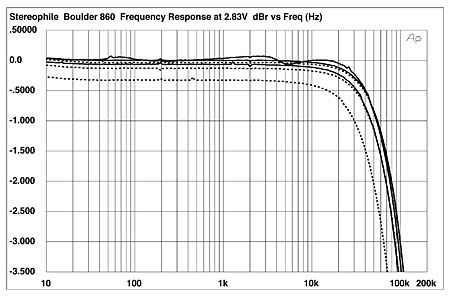
Fig.6 Boulder 860, frequency response at 2.83V into (from top to bottom at 2kHz): simulated loudspeaker load, 8, 4, 2 ohms (0.5dB/vertical div., right channel dashed).
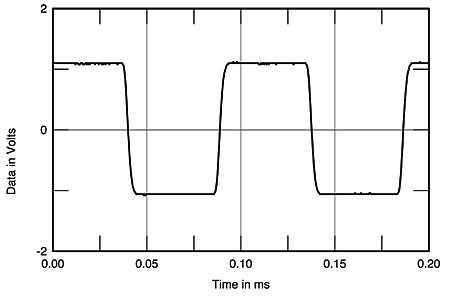
Fig.7 Boulder 860, small-signal 10kHz squarewave into 8 ohms.
Channel separation was better than 100dB in both directions below 10kHz (not shown), with the A-weighted S/N ratio (ref. 2.83V into 8 ohms, with the input shorted) an excellent 99.2dBA. It was a still-excellent 89.1dB with a wideband, unweighted measurement.
As shown by fig.8, the Boulder 860 more than met its specified power, with 210W continuously available at clipping into 8 ohms (23.2dBW), 338W into 4 ohms (22.3dBW), and 455W into 2 ohms (20.6dBW). However, the amplifier went into protection a few seconds after reaching 455W into 2 ohms. It returned to normal operation once I'd backed off the drive signal. As with the 810, the downward slope toward the left of this graph indicates that the THD is actually buried beneath the amplifier's noise at levels below 20W or so. I therefore looked at how the THD+N percentage changed with frequency at 10V output, which is equivalent to 12.5W into 8 ohms, 25W into 4 ohms, and 50W into 2 ohms (fig.9). The THD is vanishingly low into all loads below 1kHz, but rises slightly at high frequencies due to the usual reduction in the circuit's open-loop bandwidth in this region.
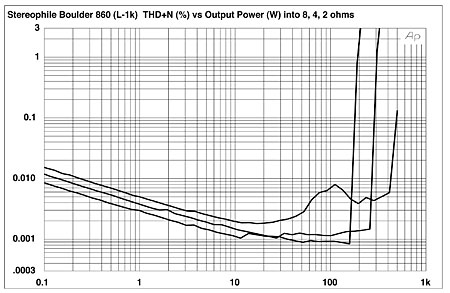
Fig.8 Boulder 860, right channel, distortion (%) vs 1kHz continuous output power into (from bottom to top at 100W): 8, 4, 2 ohms.
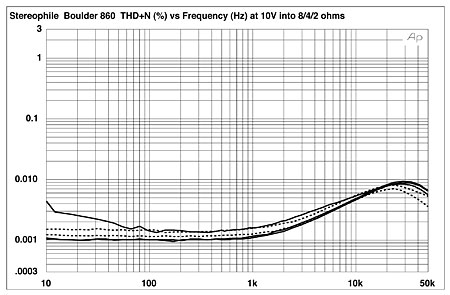
Fig.9 Boulder 860, THD+N (%) vs frequency at 10V into (from bottom to top): 8, 4, 2 ohms (right channel dashed).
As well as being very low in level, the THD was predominantly low-order harmonics, even at high powers (figs.10 and 11), while intermodulation distortion was also very low, even at a level close to clipping into 4 ohms (fig.12).
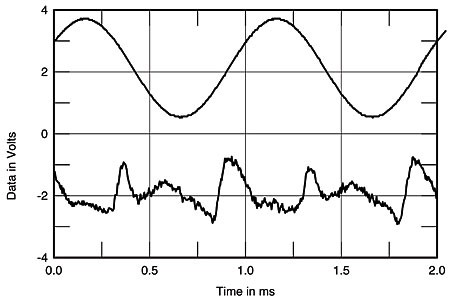
Fig.10 Boulder 860, 1kHz waveform at 95W into 8 ohms (top), 0.00084% THD+N; distortion and noise waveform with fundamental notched out (bottom, not to scale).
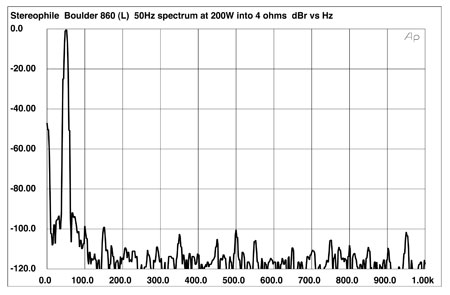
Fig.11 Boulder 860, spectrum of 50Hz sinewave, DC–1kHz, at 200W into 4 ohms (linear frequency scale).

Fig.12 Boulder 860, HF intermodulation spectrum, DC–24kHz, 19+20kHz at 260W peak into 4 ohms (linear frequency scale).
Both the Boulder 810 and 860 offer superb measured performance and are well engineered. I found no clue in the measurements as to why FK liked the preamplifier but was less impressed by the power amplifier. It is always possible that there was a compatibility issue with Fred's speakers and/or cables. I therefore auditioned the 860 with the Sonus Faber Elipsa loudspeakers that I review elsewhere in this issue using the "system described in that report. While I agree with Fred on the amplifier's rather loose quality at low frequencies, I found the Boulder's high frequencies to be silky smooth, without any trace of the upper midrange being a bit glaring or violins sounding "steely," even on the same Andrew Manze Bach recording that Fred mentioned. I also found the image depth thrown by the amplifier quite extraordinary, as did Fred.
As Wes Phillips had already auditioned the Boulder 860 in FK's system and heard what Fred had heard, I asked him to take a listen to the amplifier in his system. He reports on his findings in the sidebar to the main review.—John Atkinson
- Log in or register to post comments




































